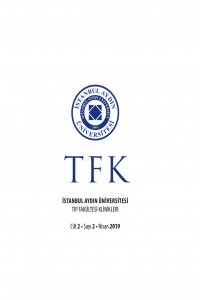Öz
Kaynakça
- 1. Münte TF, Altenmüller E, Jäncke L. The musician's brain as a model of neuroplasticity. Nat Rev Neurosci. 2002;3(6): 473-8.
- 2. Schlaug G. The brain of musicians. A model for functional and structural adaptation. Ann N Y Acad Sci. 2001;930: 281-99.
- 3. Fletcher NH, Rossing TD. The Physics of Musical Instruments. 2nd Edition. Springer, 1998.
- 4. Peckman, J. Picture Yourself Drumming: Step-by-Step Instruction for Drum Kit Setup, Reading Music, Learning from the Pros, and More. 1st Edition. Thomson Course Technology PTR, 2007.
- 5. Boucsein W. Electrodermal Activity. 2nd ed. Springer New York Dordrecht Heidelberg London, 2012.
- 6. Dawson MD, Schell AM, Filion DL. The Electrodermal System. In: Cacioppo JT, Tassinary LG, Berntson GG, editors. Handbook of psychophysiology. NewYork: Cambridge University Pres; 2007. p. 159-299.
- 7. Jentzsch I, Mkrtchian A, Kansal N. Improved effectiveness of performance monitoring in amateur instrumental musicians. Neuropsychologia. 2014;52: 117-24. doi: 10.1016/j.neuropsychologia.2013.09.025.
- 8. Nexus-10 Mark II Hardware and software installation manual, v1.02., 2007, MindMedia BV.
- 9. SPSS for windows, 15.0.1., Lead Tools 1991-2006, Lead Technologies Inc.
- 10. http://kisi.deu.edu.tr/vedat.pazarlioglu/ist2.pdf Erişim tarihi: 09.12.2018.
- 11. Anatürk M, Jentzsch I. The effects of musical training on movement pre-programming and re-programming abilities: An event-related potential investigation. Biol Psychol. 2015;106: 39-49. doi: 10.1016/j.biopsycho.2015.01.014.
- 12. Trappe HJ. Music and medicine: The effects of music on the human being. Appl Cardiopulm Pathophysiol. 2012;16: 133-142.
- 13. Lynar E, Cvejic E, Schubert E, Vollmer-Conna U. The joy of heartfelt music: An examination of emotional and physiological responses. Int J Psychophysiol. 2017;120: 118-125. doi: 10.1016/j.ijpsycho.2017.07.012.
- 14. Hodges DA. Bodily responses to music. In: Hallam S, Cross I, Thaut M, editors. The Oxford Handbook of Music Psychology. Oxford: Oxford University Press; 2009. p. 183-196.
Öz
Amaç: Bateristlerin dinlenim, performans sırasında ve sonrasında elde edilen periferik sinir sistemi elektrodermal deri aktivitelerinin (EDA) kendi içinde ve dinlenim sırasındaki aktivitenin ise müzisyen olmayanlarla karşılaştırılması, sinir sisteminin üstün özelliklerinden biri olan sanatçı yaratıcılığının nöroelektriksel temelinin psikofizyolojik yaklaşımla incelenmesi ve ilgili nöral aktivitelerin belirlenmesi amaçlanmıştır.
Gereç ve yöntem: Araştırmaya 15 baterist ve 15 müzisyen olmayan erkek birey katıldı. Katılımcıların EDA’sı ise serçe ve yüzük parmağına bağlanan disk elektrotlarla alındı.
Elektrofizyolojik veriler bateristlerde dinlenim (bazal), bateri performansı, performans dinletilirken; müzisyen olmayanlarda ise sadece dinlenimde kaydedildi.
Bulgular: Bateristlerin bazal EDA’sı, müzisyen olmayanlardan düşüktü. Bateristler en yüksek EDA’ya performansta sahipti.
Sonuçlar: EDA’nın bateristlerde, müzisyen olmayanlardan düşük olması, sahne ve gösteriye hazırlıklı olan bateristlerin bazal durumda daha düşük heyecan ve emosyonel uyarılmışlığa sahip olduğunun bir göstergesi olabilir.
Anahtar Kelimeler
Kaynakça
- 1. Münte TF, Altenmüller E, Jäncke L. The musician's brain as a model of neuroplasticity. Nat Rev Neurosci. 2002;3(6): 473-8.
- 2. Schlaug G. The brain of musicians. A model for functional and structural adaptation. Ann N Y Acad Sci. 2001;930: 281-99.
- 3. Fletcher NH, Rossing TD. The Physics of Musical Instruments. 2nd Edition. Springer, 1998.
- 4. Peckman, J. Picture Yourself Drumming: Step-by-Step Instruction for Drum Kit Setup, Reading Music, Learning from the Pros, and More. 1st Edition. Thomson Course Technology PTR, 2007.
- 5. Boucsein W. Electrodermal Activity. 2nd ed. Springer New York Dordrecht Heidelberg London, 2012.
- 6. Dawson MD, Schell AM, Filion DL. The Electrodermal System. In: Cacioppo JT, Tassinary LG, Berntson GG, editors. Handbook of psychophysiology. NewYork: Cambridge University Pres; 2007. p. 159-299.
- 7. Jentzsch I, Mkrtchian A, Kansal N. Improved effectiveness of performance monitoring in amateur instrumental musicians. Neuropsychologia. 2014;52: 117-24. doi: 10.1016/j.neuropsychologia.2013.09.025.
- 8. Nexus-10 Mark II Hardware and software installation manual, v1.02., 2007, MindMedia BV.
- 9. SPSS for windows, 15.0.1., Lead Tools 1991-2006, Lead Technologies Inc.
- 10. http://kisi.deu.edu.tr/vedat.pazarlioglu/ist2.pdf Erişim tarihi: 09.12.2018.
- 11. Anatürk M, Jentzsch I. The effects of musical training on movement pre-programming and re-programming abilities: An event-related potential investigation. Biol Psychol. 2015;106: 39-49. doi: 10.1016/j.biopsycho.2015.01.014.
- 12. Trappe HJ. Music and medicine: The effects of music on the human being. Appl Cardiopulm Pathophysiol. 2012;16: 133-142.
- 13. Lynar E, Cvejic E, Schubert E, Vollmer-Conna U. The joy of heartfelt music: An examination of emotional and physiological responses. Int J Psychophysiol. 2017;120: 118-125. doi: 10.1016/j.ijpsycho.2017.07.012.
- 14. Hodges DA. Bodily responses to music. In: Hallam S, Cross I, Thaut M, editors. The Oxford Handbook of Music Psychology. Oxford: Oxford University Press; 2009. p. 183-196.
Ayrıntılar
| Birincil Dil | Türkçe |
|---|---|
| Bölüm | Araştırma makalesi |
| Yazarlar | |
| Yayımlanma Tarihi | 30 Mayıs 2019 |
| Kabul Tarihi | 30 Mart 2019 |
| Yayımlandığı Sayı | Yıl 2019 Cilt: 2 Sayı: 2 |
All site content, except where otherwise noted, is licensed under a Creative Common Attribution Licence. (CC-BY-NC 4.0)



